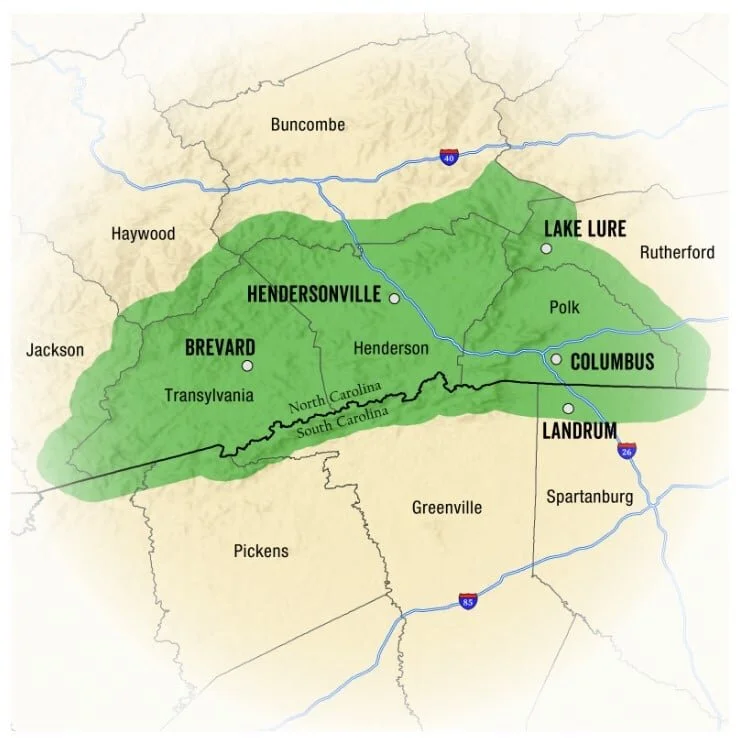Conserving Carolina
Our communities benefit from conservation in so many ways. Conservation in Western North Carolina and upstate South Carolina:
Protects the scenic beauty of our mountain and foothill landscapes.
Provides habitat for native plants and wildlife to thrive.
Provides clean water by protecting natural areas around rivers and streams.
Preserves productive farmland that we need to grow food.
Provides places for outdoor recreation.
Improves our communities’ climate resilience, as forests and wetlands reduce the impact of severe floods and storms.
Helps to preserve some of the greatest biodiversity in the United States, including many vulnerable species.
Strengthens local economies by supporting our two largest industries, agriculture and tourism.

PLACES THAT CHANGE LIVES.
We protect wonderful places for nature and people! We’ve protected nearly 46,000 acres—from the waterfalls of DuPont State Forest, to the rock faces of Hickory Nut Gorge, to the farms and rivers that provide us with food and water. These places have the power to change lives. Whether you're a passionate hiker or mountain biker, a retiree looking for ways to give back to the community, or a parent who wants your child to experience the wonders of nature, we invite you to explore these special places and get involved with Conserving Carolina. Become a member, come to an event, or volunteer!
ACHIEVEMENTS
We’ve been able to achieve a lot so far, with the support of people like you! Here are some highlights from almost 30 years protecting land and water, for nature and people. Help us keep conservation going strong in our part of the Carolinas.
We’ve protected over 45,000 acres.
We’ve played a key role in creating beloved public lands, including Chimney Rock State Park, DuPont State Recreational Forest, Headwaters State Forest, as well as additions to the Green River Game Land and Pisgah National Forest.
We’ve created numerous preserves and trails, including Bearwallow Mountain Trail, Florence Nature Preserve, Wildcat Rock Trail, Weed Patch Mountain Trail, Trombatore Trail, and Norman Wilder Forest.
We helped to establish numerous local community parks and greenways. Find one near you.
We’re spearheading the 100+ mile Hickory Nut Gorge State Trail, designated by the state legislature in 2017. Over 37 miles are completed and more are underway.
We hold over 200 conservation easements, which give private landowners a way to protect their land forever.
We support good stewardship of our conservation lands—partnering with landowners and managing our own properties. We help to remove invasive plants, restore wildlife habitat, and protect streams and wetlands.
We’ve helped create multiple preserves for research and education, which host public events, school groups, college classes, and field researchers.
We support free speaker series on environmental and naturalist topics at Walnut Creek Preserve and Landrum Library.
We lead AmeriCorps Project Conserve, which places 35 AmeriCorps members at 18 environmental organizations throughout Western North Carolina.
We offer Summer of Service, an AmeriCorps program for local 17-to-19-year-olds— providing, in some cases, a life changing experience.
WHERE WE WORK.
We serve part of Western North Carolina and Upstate South Carolina. In North Carolina, our region includes Polk, Henderson, and Transylvania Counties, and parts of Rutherford and other surrounding counties. In South Carolina, we serve the Landrum area, including parts of Greenville and Spartanburg Counties. We’ve protected over 45,000 acres in this region.
HISTORY
Conserving Carolina was formed in 2017 by the merger of two local land trusts with deep roots in our communities—Carolina Mountain Land Conservancy and Pacolet Area Conservancy.
The two land trusts served overlapping areas. Pacolet Area Conservancy was founded in 1989, with a focus on the Southeast portion of our current region. Carolina Mountain Land Conservancy, which served the North Carolina portion of our current region, was founded in 1994 as the Natural Heritage Trust of Henderson County.
After partnering successfully on several conservation projects, the two land trusts decided to join forces, combining our expertise, talents, and resources in order to strengthen our impact.









